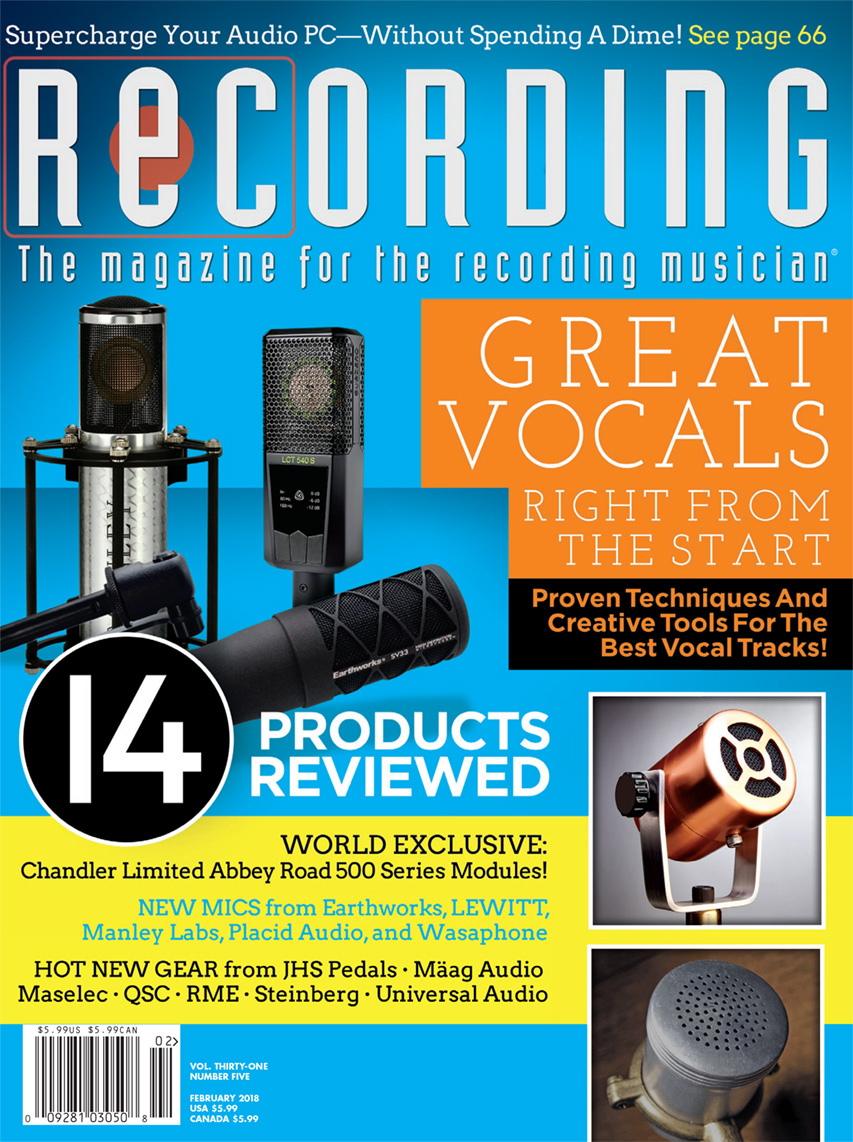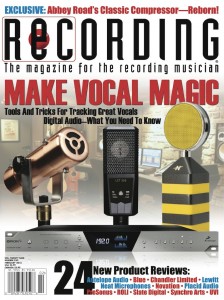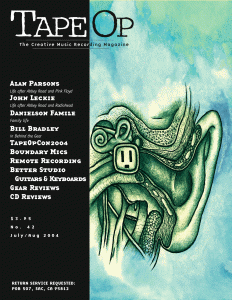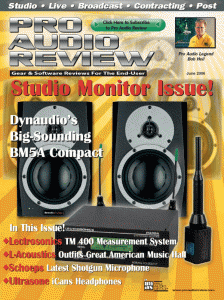REVIEW IN TAPE OP MAGAZINE (October/November 2023)
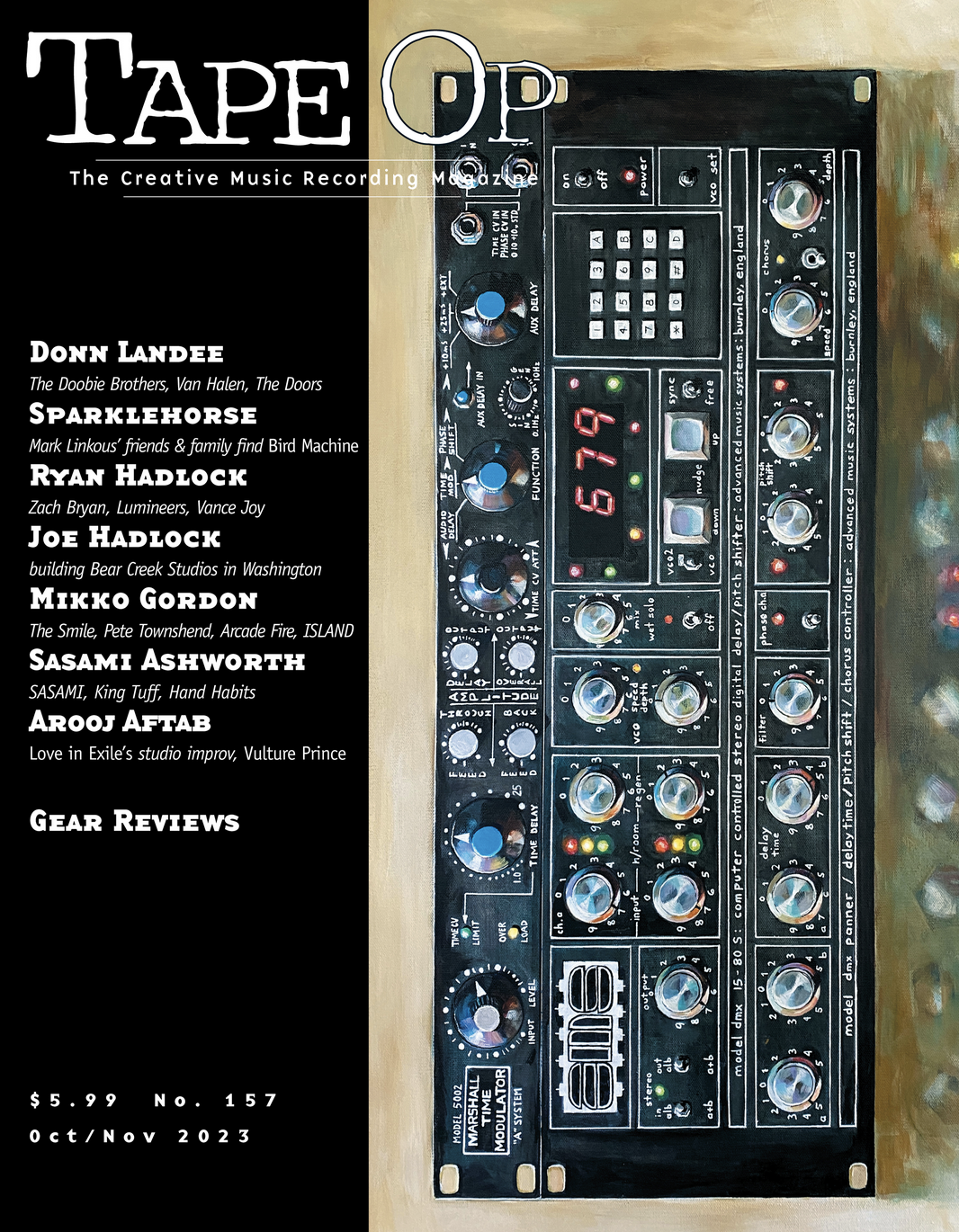
PLACID AUDIO: COPPERPHONE AV20 MICROPHONE
It has been more than 20 years since I got my first original Copperphone microphone and wrote a review for Tape Op about it [Tape Op #42]. I fell in love with that microphone the moment I heard it, and I have used it on hundreds and hundreds of recordings since. Not to mention, I have put that microphone on any and every single source I came across, and it always brought something to the recording that wasn’t only about the sound. It also brought character. Simply calling it “lo-fi” is like calling the recorded output of Billie Holiday “old-sounding.” There is something evocative in the sound of a limited bandwidth capture of a very inspired performance that also gives the listener a sense of honesty. A Copperphone, and the sound it imparts on any source, is the sound of self-awareness, or of letting the listener in. We know it’s a recording. We know it happened in a studio, and it isn’t trying to “trick” the listener into thinking it is live. The Copperphone gives a sense of gravity to the source by admitting it has been recorded, much like the quality of old film, it gives a sense of nostalgia to an otherwise commonplace situation.
At this point, I would say without hesitation that the Copperphone is a classic, and the Copperphone AV20 takes that legendary limited bandwidth sound and gives it a few tweaks that make it even more usable in the studio, and probably better at live shows with the non-resonant capsule arrangement and higher output. This microphone is something that every single studio should have. The Copperphone is like an indicator species: If I see that a studio has one or more Copperphones, I am almost sure I will wind up getting along well with the owner/operators.
If you already have some solid dynamic mics, a few condenser mics, and a few other good choices, the Copperphone AV20 would be the next thing on the list. It’s one of the least expensive mics out there that elevates the entire collection. It even has a lifetime warranty! In short, I love the Copperphone. When I pack for a session outside of Studio G Brooklyn, where we have about ten Placid Audio microphones (including four original Copperphones), I always carry a Copperphone with me. I think that choice is now going to be the AV20. ($350 direct, placidaudio.com) -Written by Joel Hamilton.
REVIEW IN RECORDING MAGAZINE (March 2023)
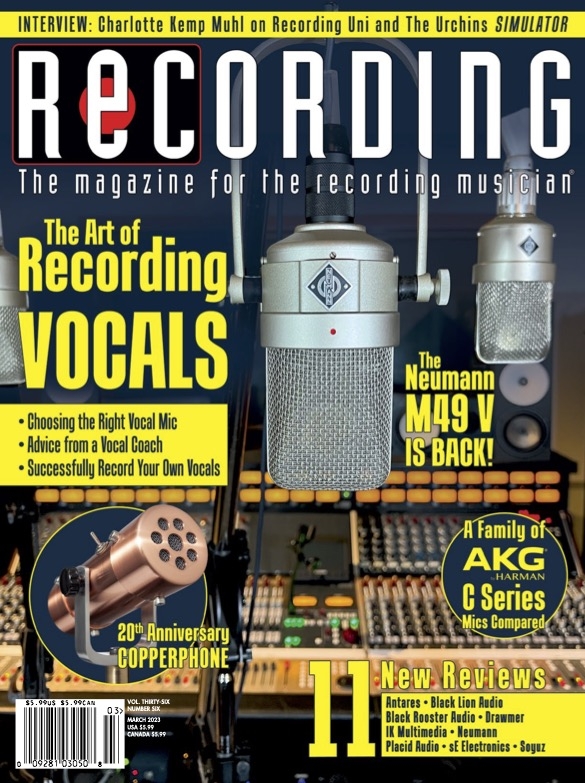 PLACID AUDIO 20TH ANNIVERSARY COPPERPHONE-20 YEARS OF HIGH-QUALITY LO-FI GOODNESS
PLACID AUDIO 20TH ANNIVERSARY COPPERPHONE-20 YEARS OF HIGH-QUALITY LO-FI GOODNESS
The new Limited Edition 20th Anniversary Copperphone, while visually similar to the original Copperphone, is a wholly different yet complementary mic. The body remains the same, but while the yoke looks similar, it is now made of machined aircraft aluminum. It uses a silver double-layer mesh grille, and most importantly, you will notice a two-position silver toggle switch on the top.
Placid Audio founder Mark Pirro offers an in-depth look at what is going on inside and out in the accompanying interview. Still, in simple terms, the 20th Anniversary Copperphone uses a new capsule with a step up transformer and the above-mentioned Dark Switch (a fixed low-pass filter) that darkens the mic’s tone by rolling off the high frequencies.
NEW COPPER-TONES
Thanks to a step-up transformer, the 20th Anniversary Copperphone offers about 6–7dB of increased gain over the original until you engage the Dark Switch, which then drops the level back down within a dB of the standard model.
I was surprised at how different the two models sound. The stock Copperphone has a touch fuller range and sounds more hi-fi—an odd thing to say, I know. I think the original’s rear-ported capsule design and resonant chamber give the mic a bit more extended, albeit a round, hollow fullness.
In contrast, the 20th Anniversary Copperphone is more dry and immediate sounding. Paradoxically, the new model is richer, sounding especially up close and personal, and it reaches farther into the upper frequencies than the original.
One benefit Mark points out (that I was unable to try) is that when used live, the 20th Anniversary Copperphone should offer even better gain before feedback than the original, due to not having a rear-ported capsule.
GOING DARK
Engaging the Dark Switch makes the mic much smoother, rounder and muffled in a beautifully lo-fi way.
Again, all of the rules and usage of the original apply. Use it up close for nostalgic intimacy and nuance, use it as a distance for vintage-inspired yet modern lo-fi sound design, and especially play around with the 20th Anniversary Copperphone layered with your favorite condenser, ribbon and dynamic mics for unique added flavors and textures. I like it a lot on a bass cabinet, guitar amp and for reamping digital sources like soft synths through your studio monitors.
IT’S A WRAP
It’s hard to be critical of a lo-fi mic by design, and it comes down subjectively to the question, “Is this the lo-fi sound you need?” Nicely there are now two Copperphone choices, and you might want both.
The 20th Anniversary Copperphone and original Placid Audio Copperphone are fantastic tools for adding lo-fi nostalgic tones to your recordings, and as history has proven, the Copperphone is built to last. -Written by Paul Vnuk Jr.
REVIEW IN RECORDING MAGAZINE (February 2018)
In an issue dedicated to capturing vocals, one might expect to find reviews of microphones that are smooth, hi-fi, and pristine. We do have a fair number of those, but the next microphone we are looking at is all about unique lo-fi character. It’s based on the most ancient of microphone technologies, the humble carbon element.
COLD WAR, HOT MICS
The RU-80 is the second Carbonphone in Placid Audio’s lineup. Mike Metlay looked at the original model, along with its 5-position external Tone Box, in our February 2016 issue. He described it as the perfect mic for “recreating hundred- year-old radio shows.”
Sonically the Carbonphone is a distant, thinnish, distorted, sibilantly spitty and largely unpredictable mic. In other words, it’s perfect for lo-fi vocals, drums, and instruments with a healthy dose of edge. Its included phantom-powered Tone Box allows you to further tweak and tune the mic with preset EQ filters to suit your taste and mix. I love my Carbonphone; Mike let me try it after the review and I ended up trading him my Copperphone Mini for it! (It’s a Placid thing; if you own these mics, you’ll get it.)
The element in the original Carbonphone is from a US battle tank intercom mic. By contrast, the new RU-80 is made from 1970s Cold War era Soviet military components. The body of the RU-80 is made from a pair of lacquered copper endcaps from the company’s Copperphone/Resonator models. It is shorter and wider than the original model, and retains its predecessor’s aluminum swivel yoke and rear-mounted Switchcraft XLR connector.
The cardioid RU-80 features a transformer-balanced output using the same Hammond transformer found in the original Carbonphone. All carbon mics, old and new, require voltage; the RU-80 does use +48V phantom power. While it doesn’t come with—or need—a Tone Box of its own, it will work just fine with one if you already own the previous model.
CARBONOSTALGIA
Sonically the RU-80 retains all of the above sonic anomalies of the original Carbonphone, yet it is noticeably darker, richer, and less bright and tizzy, with a 50 Hz–10 kHz frequency response. Mark Pirro explained to me that the RU-80 is a tad truer to a vintage carbon mic; it’s fuller in bandwidth than the original Carbonphone, which he deliberately band-limited in its circuit design to produce its lowered fidelity and unique interaction with the Tone Box. This makes the two Carbonphones different from one another and quite complementary.
On vocals, the RU-80 is great up close and personal. Despite its distorted and rough-edged character, it’s a mic that a singer can really play to. Unlike using singer distance and level to control proximity effect and intimacy on a “normal” mic, here you work the mic to control tone, feel and grit. Long crooner-style sustained notes can be thick and smooth, and distortion is caused by fast transient bursts and sibilant sounds (as Mike noted in his review of the Carbonphone).
On instruments at a distance, this transient breakup is a neat effect on bright sources like hi-hat, tambourine, brass stabs, and jangly guitar strings. On low sustained tones like bass cabinet, keyboards through an amp, cello, and even violin, the tone is more rich and gravelly.
RU READY?
The RU-80 is Placid Audio’s lowest-toned and grungiest model yet, and I say that with love. It offers a great flavor that lives nicely alongside the original model, and adds a great X-factor to any song, either blended with other Placid Audio models or with traditional mics. Think of it as an overdrive tool that does not require an effects box or computer process! -Written by Paul Vnuk Jr.
REVIEW IN RECORDING MAGAZINE (July 2017)
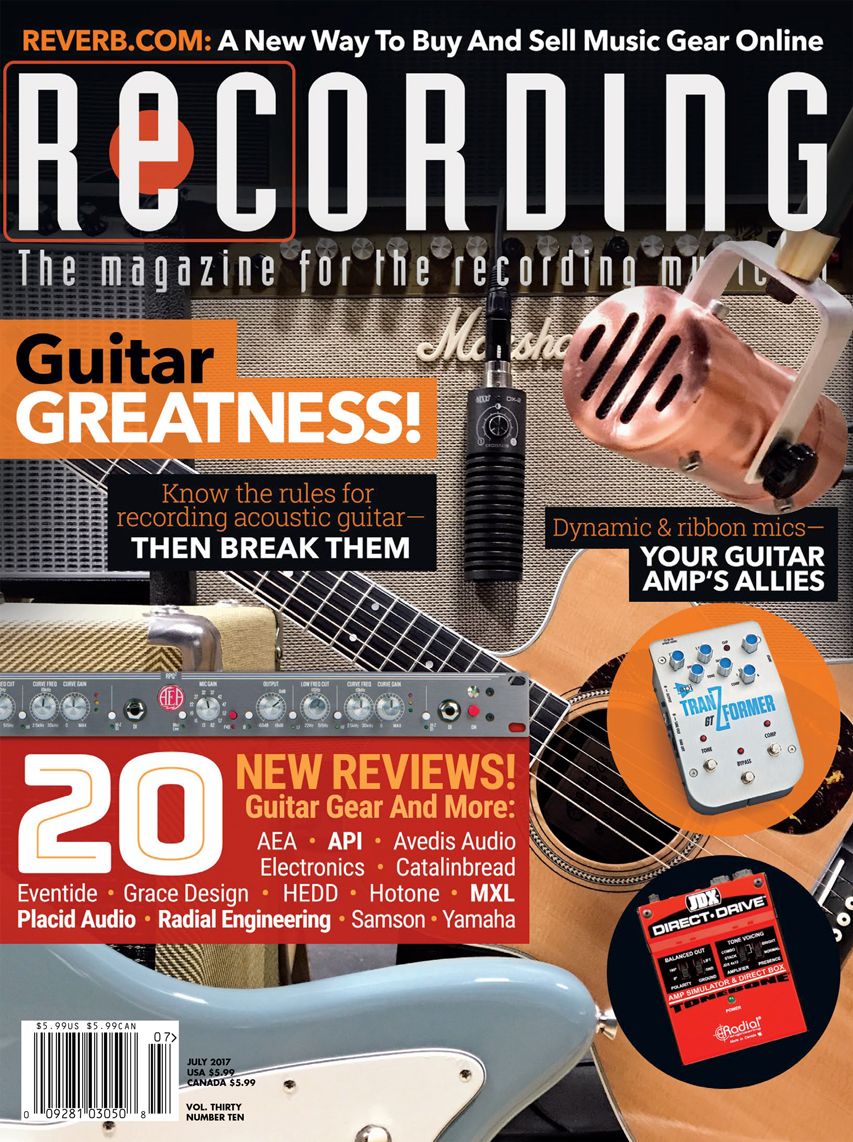 PLACID AUDIO RESONATOR SERIES – WE GAVE THEM A SNEAK PEEK EARLIER THIS YEAR, NOW IT’S TIME TO CUT LOOSE ON GUITARS!
PLACID AUDIO RESONATOR SERIES – WE GAVE THEM A SNEAK PEEK EARLIER THIS YEAR, NOW IT’S TIME TO CUT LOOSE ON GUITARS!
In our February 2017 issue, we brought you a quick preliminary look at the two newest members of the Placid Audio family: the Resonator Series. That review focused on the new mics’ use on vocals. This month we return to the Resonator and bring you an in-depth look at the application for which they were primarily designed… guitar amps!
Placid Audio is a microphone company helmed by Tripping Daisy/Polyphonic Spree bassist Mark Pirro. Placid Audio’s Copperphone mic is the original steampunk lo-fi mic. Originally the Copperphone was invented to add live phone-line style vocals to Polyphonic Spree concerts, but soon Copperphone found their way into studios… and general mayhem has ensued ever since.
All Placid mics come housed in copper tubes seated on large metal yokes. Beyond their lo-fi old radio/telephone sound when used on their own, Placid Audio mics play well with other microphones in multi-mic situations when blended in as a cool added tones you can’t get with EQ. This is especially true of Mark’s two newest models, the Resonator A and Resonator B, especially on guitar cabinets.
WHAT’S RESONATING IN A RESONATOR?
Both models are built inside the same 2.5″ x 6″ copper body as the original Copperphone, yoke and all. Visually, the Resonator A and B are only differentiated by the orientation of the lines on their head grilles.
The Resonators use a mylar dynamic capsule vs. the Copperphone’s aluminum capsule, and are internally baffled with a front-ported resonant chamber. The Copperphone’s transducer, by contrast, is rear-ported. The Resonators are also less band- limited, more low-mid focused, have more headroom, and are less prone to clipping than the upper-mid focused Copperphone.
Comparatively, Resonator A is the model with the fuller sound, but at the same time it has a distant tunnel-like character. The Resonator B is thinner and sizzles a bit more. It has the sound of an old wire recording, crunchy top and all, but somehow cleaner at the same time.
PLAYING WITH THE OTHER KIDS
Rather than suggesting that buyers choose one or the other model, I think Placid Audio should consider selling the Resonators as a 2-piece kit. Why? Because they fit together so well, especially on guitar cabinets in tandem with a “normal” dynamic or ribbon mic. The standard dynamic mic grabs the usual thick forward punch that we are used to on a guitar cabinet, while the Resonators, when blended, add in a unique high-end openness and a touch of abstract roughness to the sound.
When set up as a pair on their own, one on axis to the cab speaker and the other off, the result is a great old-world blues amp sound. It’s like listening to an old 78 record… minus the clicks, static and pops.
IN USE
I used the Resonators in a variety of set- ups over several months. My favorite guitar amp trick was pairing them with a third mic. While any moving-coil dynamic mic or ribbon mic could work for this application, I especially enjoyed teaming them with MXL’s new DX-2. In this three-mic setup, place the standard dynamic or ribbon mic in the center of your mix, and pan each of the Resonators hard to the sides. Then send all three mic tracks to a stereo bus and add a stereo FET or opto-compressor to glue them together. This creates a unique, wide illusion for otherwise mono guitar tracks, with an amazing high end that you need to hear for yourself. It’s an especially cool trick to do with an amp containing a spring reverb, as the Resonators add a cool lo-fi sheen to the top end of the ’verb.
Interestingly, the electric guitar isn’t the only string instrument where the Resonators shine. On acoustic guitar and mandolin, I like the Resonators in place of a bright pencil condenser around the 12th fret, combined with a large-diaphragm condenser mic just to the side of the sound hole. This gives a nice rough edge to an acoustic guitar for a rock mix. Here, either mic will work, but I like the sound of Resonator A better. I also like using the Resonators as massively compressed room mics!
As always, the Resonators won’t be your first or only mics, but they are great special utility mics that always yield interesting artistic results. They may have been designed originally for guitar cabinets, but they beg for experimentation on any source! – Written by Paul Vnuk Jr.
REVIEW IN TAPE OP MAGAZINE (May/June 2017)
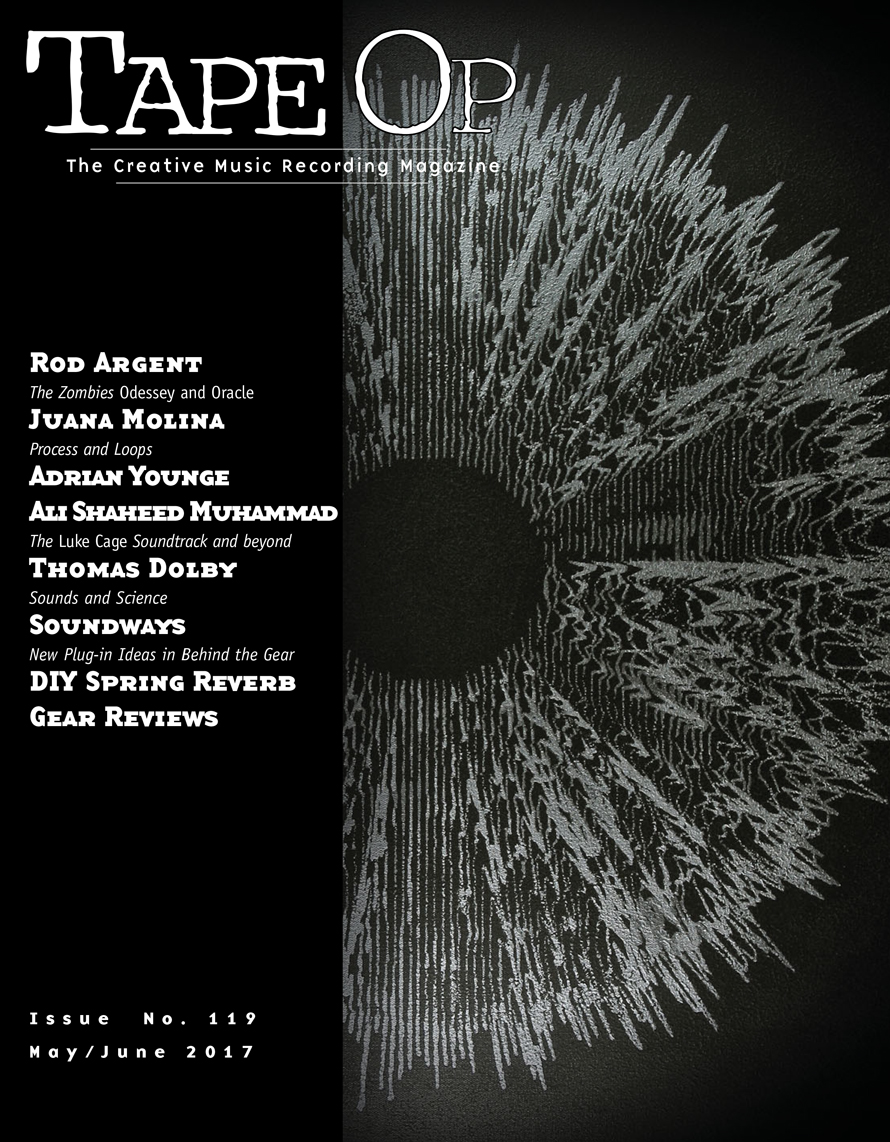 PLACID AUDIO: RESONATOR A & B DYNAMIC MICS
PLACID AUDIO: RESONATOR A & B DYNAMIC MICS
When a piece of equipment comes along that challenges the norms of the day, I always take notice. “Normal” is an ever-shifting sandbar in the harbor of consensus, and it never holds still for long in our business. Placid Audio came along many years ago, and from their first run of Copperphone mics [Tape Op #42], I bought one right away; and after hearing it, I subsequently bought a few more. With the initial release of the Copperphone, there were folks that embraced the concept right away, and those that simply didn’t get what it was meant to do. “So it’s meant to sound broken?” Jump to over a decade later, and the Copperphone has become something of a standard, or at least an indicator that you are in a certain type of studio that understands that this is a valid color on the palette as much as any other.
Now, Placid Audio has released the Resonator mics. In practice, they are like the Copperphone — limited bandwidth and full of character in the range they are willing to reproduce. I was lucky enough to try a handful of Resonator mics as part of a beta-testing type situation, that ultimately narrowed down a varied group of mics to two models — Resonator A and Resonator B.
I had Bernard Purdie in the studio, along with the Charles Bradley horns and some other killer musicians, and both Resonator mics saw some love on the drums. For example, I had the Resonator A near the hi-hat, to the right of the kit (audience perspective — always), and it did exactly what I had hoped it would do; it caught weird peaks in the toms and snare, and gave an interesting midrange character to the whole kit, but mostly to the snare and hat. It immediately reminded me of the breakbeats I love from the late ‘60s through the mid ‘70s — the “clack” of the hat and snare, and the consistency of the overall sound.
When I am mixing, I know the “DNA” of a given track is in the midrange. It’s that DNA that will inform the development of the lows and highs, and the depth and width of all the other elements. With a midrange character that is alive and resonant and animated, the low end can be bigger. With a midrange character that remains transparent and yet somehow anchors the center of your mix, the stereo image becomes easier to widen without giving a sense of synthesized space. The Resonators can inject some of this midrange character into the rest of the tracks you are capturing. The Resonators can infuse the sounds with some of that DNA that allows for low-end extension, while holding the mix in place and helping to keep the composition and arrangement balanced for all of the harmonic content. The Resonators can also bring a sense of nostalgia to that midrange character, even when the lows and highs are extended in a very modern and hi-fi way — again, with a tip of the hat to the vintage sounds of mixes made before tweeters, or for playback formats that were not up to reproducing 20 Hz – 20 kHz.
The difference between the Resonator A and B models is not that dramatic. The way I use these mics, it almost doesn’t matter to me which one is put up. The heresy in that statement will surely be tempered by the subtlety of the choices, and the fact that both mics have the same end result — the midrange character is enhanced and modified. The way it is modified is as varied as any mic placement/application ever has been, and so the fact that there is a difference at all to the two Resonator offerings simply means you can choose between them, or not.
I am a complete fan of Placid Audio and the company’s new Resonator A and B mics. These are valid choices, even if your collection already includes a Copperphone or Copperphone Mini [Tape Op #85]. (I have a couple of both.) I have used Placid Audio mics on tons of sources — from drums to Marxophone to horns to vocals to Optigan — and they always seem to create energy in the midrange that is incredibly useful during the mix. The new Resonator mics are no exception. (Each $269.99 street; www.placidaudio.com) – Written by Joel Hamilton.
REVIEW IN MIX MAGAZINE (February 2017)
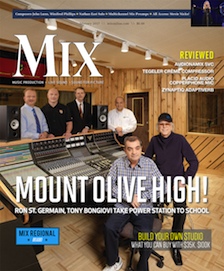 PLACID AUDIO COPPERPHONE – PERSONALITY TRANSDUCER OFFERS LOW-TECH CHIC
PLACID AUDIO COPPERPHONE – PERSONALITY TRANSDUCER OFFERS LOW-TECH CHIC
Engineers and music producers are always looking for that certain something in a production that sets their tracks apart from the rest. It could be a high-quality signal chain offering pristine high fidelity, or at the other end, some distortion or trash to bring personality to a recording. The Copperphone from Placid Audio falls into the latter category.
It’s a dynamic, moving-coil mic offering a fixed, narrow bandwidth output centered between 300 Hz and 3 kHz. The microphone gets its name from its appearance; the exterior shell is a 2.5 x 6-inch, polished copper body featuring an integral metal mic mount and a Switchcraft XLR. Inside, a passive, magnetic moving-coil element is mounted in a tuned resonant chamber that all works together to produce its signature, and unique, sound.
The review unit that I received is the company’s flagship model, but Placid also makes the Copperphone Mini ($299); the Carbonphone ($425), offering variable control over the frequency range of the mic; and the Resonator A ($270) and Resonator B ($270), each offering its own low-tech spin at output.
Being a one-man operation, Placid Audio also has a custom shop. On the company’s website, you’ll find the following offer: “Have an idea for a modification to one of our current models? Do you have a completely new idea for a one of a kind microphone? Maybe you are you looking to convert an old/ broken vintage microphone with a custom or replacement circuit? Or would you simply like a personalized name plate added to your Placid Audio microphone?” If you want it, owner/designer Mark Pirro can create it for you.
DRUM TRASH
My philosophy when using odd products like this is to stretch boundaries and see what happens. If it works, fine; if not, all I’ve lost is time. For starters, I used the Copperphone around a drum kit to see what it would offer. After trying a couple of different placements, I found a winning position where the Copperphone gave me equal parts snare and kick attack. I carefully snuck the mic perpendicular to the right beater side of the kick drum, pointing it at the snare body. The microphone was out of the drummer’s way, looking across the kick drum from the low tom side, so there were no complaints there.
The Copperphone sound is very much like the “telephone” sound that you can get by dialing in lowpass and highpass filters—it instantly sounds trashy in a good way. In the body of the entire recorded kit, it worked when I just ghosted the Copperphone track in underneath the full-bandwidth tracks. But the power here is to make the output more dynamic in the framework of the entire track. To accomplish this, I stripped out the audio between transients on the Copperphone track using Pro Tools Strip Silence. Then I batch faded them all with a quick 10ms fade in and a 150ms fade out. Next, I muted all of the hits and then picked out select groups of transients to appear only on drum fills, accents, breaks and other choice spots.
Once I compressed the Copperphone track and tucked it into perspective (feeling more than hearing), it instantly brought that “What was that?” coolness to the track. The point is, with something as stark as the Copperphone, you have to do some work to bring finesse to the outcome.
VEHEMENT VOCALS
I’m always looking for trash on rock vocals, and in addition to my main mic, I use a Shure Green Bullet through a guitar amp recorded to an additional track to give me something to work with. The Green Bullet sounds fantastic in this application. But you
need an extra room for the amp to keep it out of the clean feed, and mounting the Bullet on a stand calls for gaff tape, making positioning difficult.
The Copperphone has a proper stand mount, so putting it next to another mic on another stand, a Neumann U47 in this case, was easy. I could tuck them both together tightly behind one pop filter. Rather than an amp, I chose to run the Copperphone into two consecutive EMI V76 mic preamps to gain up the distortion, which I recorded directly to Pro Tools.
During my tests, I found that the approach of pairing the personalities of the Green Bullet and Copperphone worked very well in putting some space between these two personality mics. The lead vocal using the Green Bullet had more of a throaty sound with frequencies targeted lower than the Copperphone. So I used the Copperphone on backgrounds and doubles.
Once these tracks were mixed with the main mics, then muted dynamically, and even trashed further with Soundtoys Phase Mistress or other plug-ins, it provided me with an infinite variety of dynamic vocal options in the song. Once again, a bit of extra work made this one-trick pony more full-featured.
TRY THIS
If you want to record trash vocals taken to the nines, use a low-to-high impedance adapter like the Whirlwind Little IMP, or Shure A85F, to plug the Copperphone directly into a guitar amp set for distortion. I usually run this parallel to a proper vocal mic, giving me many options later. You can put the amp in an iso to keep it out of the clean feed, or make a commitment and place the guitar amp at the feet of the singer, miked separately in the same room (kudos to Vance Powell for that idea).
ACOUSTIC EXPERIMENT
Finally, I placed the Copperphone next to an Audio-Technica AT5045 to record an acoustic guitar. To be honest, I just did this for fun’ O was not thinking that it was something I’d ever really use. However, once again, the Copperphone turned out to add that extra something that was useful when carefully mixed below the main microphone. The effect was to give the mellow guitar some extra edge, making it peek through the busy track. Mark Pirro from Placid Audio suggested that I try his mic on a piano, but before this writing I never got the chance. Believe me, I will soon because this mic brings the fun-factor up to ten.
DO YOU NEED IT?
Placid Audio’s Copperphone microphone is an affordable, personality-plus transducer that should find a home in every mic locker. There is no other microphone like it in its category and price range. It’s easy to rely on your tried-and-true favorites when tracking and overdubbing, but having the Copperphone around makes you stretch—and that’s a great thing. So get one, or two; at this price it’s a no-brainer. – Written by Kevin Becka
PRODUCT SUMMARY
Company: Placid Audio
Product: Copperphone
Website: www.placidaudio.com
Price: $265
Pros: Easy to place. Affordable Brings a unique sonic character to any application.
Cons: Not your versatile “everything” mic – this is a personality product.
REVIEW IN RECORDING MAGAZINE (February 2016)
PLACID AUDIO CARBONPHONE – THE WORLDS FIRST MICROPHONE MAKES A FASCINATING COMEBACK
Mark Pirro of Placid Audio has a mission—to build microphones whose character is unmistakable and unique. He’s not about “flexible Swiss Army mic that sounds clear and clean on multi- ple sources”…. he’s about “Oh my gosh this mic doesn’t sound like anything I’ve ever heard before and I love it”.
Pirro’s first microphone was the Copperphone (September 2008), developed for Polyphonic Spree bandmate Tim DeLaughter to provide a band-limited “old time radio” voice effect for the Spree’s live shows. It was followed by the Copperphone Mini (reviewed July 2015), a smaller version with a slightly different tonality. Both Copperphones received glowing reviews for their unique character, but compared to the Carbonphone, they’re positively pedestrian….
CARBON?
Yes, carbon. Articles in this magazine usually talk about the three types of mics—dynamic (a speaker in reverse), condenser (a capacitor), and ribbon (a vibrating metal ribbon in a magnetic field). Those aren’t the only mic types out there; they’re merely the ones that are popular in studios today.
There are other ways of transducing sound waves into electricity, and the carbon mic is the very first, invented by David Edward Hughes in the early 1870s. A carbon mic consists of two discs separated by loose-packed carbon granules. Sound waves hit one disc and make it vibrate, causing a variable pressure on the granules, which changes their resistance over time and creates a variable electric signal.
If you were to unscrew the mouthpiece of a pre-electronic telephone as were common around the world for most of the 20th Century, a self-contained carbon “button” mic would fall out. They’re still in use today; they can provide a strong signal from very low voltages, so they’re handy in situations where higher voltages are dangerous because sparks can cause explosions—think oil refineries or coal mines. They’re also very sturdy and highly resistant to sudden voltage transients, which makes them lightning-proof (and nuclear bomb EMP-proof, if you worry about such things).
However, there’s a reason they’re not in common use, and never got closer to a studio than early radio broadcasts—where they were abandoned as soon as vacuum tube amplification made other mic types viable. Carbon elements have a very, very restricted frequency response—they’re the reason why we think of a midrangy and distant sound as a “telephone voice.” Instant dealbreaker for most engineers… and just the sort of thing that Mark would find intriguing.
THE MIC AND IT’S BOX
The Carbonphone, like its siblings, is packaged in a polished copper casing that’s been sealed with clear lacquer to prevent patina. It’s mounted on an aircraft aluminum bracket that features a standard 5/8″ threaded mic stand socket, and uses a conventional Neutrik XLR connector. Internally, the military-grade carbon granule element (used for intercoms in battle tanks) is connected to a Hammond output transformer for a balanced output that can handle very long cable runs with ease.
The Carbonphone mic comes bundled with a nicely-finished birch box with an LED and click- knob on the front, and Neutrik XLR in and out plus a 9V power plug on the back. This is the Tone Box, which isn’t vital to using the Carbonphone but greatly adds to its flexibility.
The Tone Box is a phantom power source for the Carbonphone and has five different filter settings built in. There are no specs on the filters; they’re meant to be listened to and selected for a particular application. Some are thinner and more tinny, some pass more lows, and some have interesting resonant peaks, all with very distinct character. If you plug the Carbonphone directly into your mixer and hit it with phantom power, it will need gain settings roughly similar to those of a dynamic mic, and provides yet another tonality, with a hair more bottom end than the Tone Box provides. Six sounds in one—not too shabby!
IN USE
The Carbonphone has to be heard to be understood. This is a deliberately “funky” sound, with sputtering, crackles, and a glorious 500 Hz to 10 kHz frequency response. Mine had a lovely gritty timbre but was surprisingly fussy about sibilants (easily tamed with a touch of de-esser). I actually found it sounded a bit better after I smacked it a few times to loosen up the carbon granules—a process recommended by Placid.
I used it live on the air for my weekly radio voiceovers and got all kinds of comments from the audience, most of which boiled down to “It’s really weird, but I like it!”. It lends a similar old-timey character to singing, but is even more steampunk than the Copperphones, which I didn’t think was possible!
I also tested the Carbonphone on acoustic guitar, winds, and hand percussion, and in each case it added a certain something to the tone that really caught the ear. You wouldn’t record a whole song with it, but as an accent it’s undeniably fascinating. I also tried out the Tone Box on a couple of other mics and found it a lot of fun for playing with tonality, lending a little of the Carbonphone’s mojo to otherwise pristine mic sounds.
SO
This isn’t an “I need it” mic unless you’re deliberately recreating hundred-year-old radio shows. It is, however, an “I want it” mic for folks interested in sounds they can’t get any other way. Check out the audio samples on the Placid Audio website for yourself. I think you’ll be very impressed with what this hand-built piece of real audio history has to offer.
All together now: “I heard you on the wireless back in ’52…” – Written by Mike Metlay
REVIEW IN RECORDING MAGAZINE (July 2015)
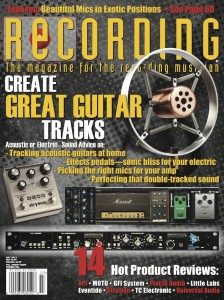 PLACID AUDIO COPPERPHONE MINI – SPECIALTY MICS DON’T GET MUCH MORE SPECIAL THAN THIS!
PLACID AUDIO COPPERPHONE MINI – SPECIALTY MICS DON’T GET MUCH MORE SPECIAL THAN THIS!
Placid Audio is a microphone company well known for the Copperphone, a microphone with a homemade handyman look and distinct lo-fi sound. Justin Peacock reviewed the original back in August of 2008 and his conclusion was that it “inspires creativity” (in addition to frightening airport security personnel because of its superficial resemblance to a pipe bomb). This month we are looking at the Copperphone’s baby brother, the Copperphone Mini.
Before we begin our review, let’s look to the original for some context. The Copperphone was invented by Mark Pirro, the bass player for the indie music collective/band The Polyphonic Spree. Mark invented the mic out of old communications components and stuffed them into a copper pipe—this was steampunk before it was a trend. The first one was made for the Spree’s lead singer to use live for lo-fi, old school radio and telephone effects. The original was a cardioid patterned dynamic mic with a Frequency Response of 200 Hz to 3 kHz with a 150 ohm impedance. Sonically it was distant, resonant, hollow, band limited and essentially insta-old-timey-vintage. If you wanted that sound, no plug-in or effects processor quite matched the rich character of the Copperphone!
IN USE
In his review of the Copperphone, Justin called the original a one-trick pony. The Copperphone Mini certainly is as well, but it’s a beautifulpony that does a very cool trick!My point here is that this is not a mic review where I can say that it was good on this source and bad on that one. I can only say that it has a unique sound of its own, one that’s distant and almost ethereal. Anything you record with it will sound like it came through an old radio, or off of a vintage 78 played on a windup Victrola with a horn for a speak- er… minus the static, clicks, and pops. All of this is the cool and creative part of this mic!
So far in the studio, I have used it as a room mic on drum kit, as a second mic on a guitar cabinet, on acoustic guitar, and of course on lead and backing vocals. Not only is it great for the obvious “let’s make this part sound old” trick, but it is actually great for blending with other mics. The blend provides unique tonal results at the source rather than adding EQ and filters later in the mix. Wait, that’s a second trick… I also used it at a live electronic music festival in Asheville, NC recently, where it was my only mic for adding singing bowl, shakers, wind drums, and claves into a live loop in a big reverb. What I liked was how the sound in the reverb had a distant nostalgic vibe to it that really sat back in the space. And yes, it looked really cool on stage; I got a whole lot of “Wow, what is that? It looks amazing!” from my fellow musicians and festivalgoers before my set… and more significantly, after my set, where I heard a lot of the same statements, but now with the words “it sounds amazing” at the end.
Specialty mics don’t get much more special than this! Now let’s meet the Mini… The Mini was originally conceived as a handheld harmonica mic, which it can still be thanks to an included conversion kit, but Mark decided to make it a full-on Copperphone in its own right and placed it into a vintage-style spring suspension mount that looks really cool! I leave it out on my mixing desk on a tabletop stand at all times, just because it inspires conversation.
It is smaller and shorter than its big brother and does away with the original Copperphone’s internal resonant chamber in the process. This makes it more direct-sounding, but as you will see, Mark made it even more band-limited than its larger sibling. It measures a tiny 1.75″ x 2.25″ and weighs 12 ounces; the shockmount measures 6″ x 0.75″.
It is a dynamic cardioid mic, but as mentioned, it has a 200 Hz–1.4 kHz frequency response and 150 ohm impedance. While it’s a bit more band-limited than its predecessor, it has a more modern mic element, making it more sensitive than the Copperphone was.
PHONE IT IN
The Copperphone Mini is a very inspiring mic, just as its big broth- er was; It truly does make you want to find uses for it. At $299.99, it is about the same price as an upper-tier dynamic mic, and while it may not be as universally useful as a Shure SM7B or a Sennheiser MD441 or an Electro-Voice RE20, it has a charm all its own. Its greatest trick is how it manages to sound vintage and lo-fi, but not crappy and cheap!
The fact that it can be dismounted from its suspension ring and can double as a harmonica mic is just icing on the cake. If you want something truly unique in your mic locker that’s as musical as it is unusual, check out the Copperphone Mini. – Written by Paul Vnuk Jr.
REVIEW IN ELECTRONIC MUSICIAN MAGAZINE (May 2015)
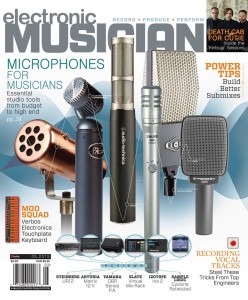 PLACID AUDIO MICROPHONES – INDUSTRY STANDARD CHARACTER MICS FOR STAGE AND STUDIO
PLACID AUDIO MICROPHONES – INDUSTRY STANDARD CHARACTER MICS FOR STAGE AND STUDIO
Among the most popular companies making band-limited mics is Placid Audio, whose products have been used by dozens of well-known engineers. The mics are housed within a copper case, built in the USA and come with a lifetime warranty.
The Copperphone ($259.99) is a moving-coil dynamic mic with a cardioid pattern and a 200Hz to 3kHz frequency response. The tuned, ported chamber is attached to a mounting bracket made from aircraft aluminum, which also allows for horizontal positioning.
Slightly smaller in size and cradled in a vintage-looking shockmount, the Copperphone Mini ($299.99) has a slightly reduced frequency range (200Hz to 1.4kHz). When removed from the shockmount, its diminutive size makes it suitable for handheld use by harmonica players.
The newest mic in the line is the Carbonphone ($399.99), which utilizes a carbon-granule capsule as the transducer and copper for the housing and parts, and includes a Hammond output transformer, an XLR jack, and an aluminum mounting bracket. The mic comes with a 9V-powered, variable-filter Tone Box to shape the timbre of the mic. Although the Carbonphone’s frequency response is stated as 500Hz to 10kHz, the Tone Box narrows it further to bring out different tonal characteristics from your sound source. The Tone Box also provides phantom power and can be used with other microphones as well. – Written by Gino Robair.
REVIEW IN RECORDING MAGAZINE (August 2008)
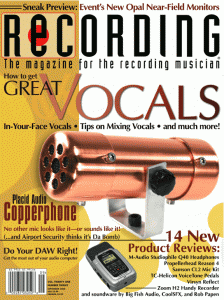 PLACID AUDIO COPPERPHONE – WHEN WE SAY “SOMETHING DIFFERENT” WE MEAN IT
PLACID AUDIO COPPERPHONE – WHEN WE SAY “SOMETHING DIFFERENT” WE MEAN IT
When I first saw a picture of the Copperphone, I had no idea what to think other than I had to try it. In true home-brew-tinkerer fashion, Mark Pirro makes Copperphones by hand, one at a time, in his garage. And the result is stunning.
WHAT IS IT?
The Copperphone is a dynamic microphone manufactured with vintage communications components and telephone parts. This is instant lo-fi audio in the most classy and fabulous sense – just point it at your source and enjoy. The Copperphone is a piece of copper pipe with a brilliantly simple stand mount. It weighs a ton, and must be rather well damped inside. Aside from that, there is little else to know. Frequency response is limited to basically all midrange, and the polar pattern seems pretty omnidirectional, but that’s just my personal observation.
WHERE FROM?
I held my first Copperphone – a very used and abused sample, I might add – following one of the most incredible live concerts I’ve ever seen. You see, the father of the Copperphone is also the bass player for the Polyphonic Spree, a 23-member symphonic rock band of epic proportions. Spree lead singer Tim DeLaughter uses the Copperphone on certain tunes, and it was fantastic to hear the mic in a live setting. ”As the bass player for The Polyphonic Spree I have watched Tim DeLaughter, (lead) singer in the band, search sonically for the perfect nostalgic “telephone” effect for his voice,” says Mark Pirro. To fill this pretty unique niche, Mark thought it would be great to have a microphone that could create DeLaughter’s phone effect live, rather than deal with effects and switching in the live setting. And, following lots of tinkering and tweaking, the Copperphone was born.
GETTING SOUNDS
The most likely place to start was vocals. Since the voice is the most familiar of instruments to us all, you can really hear the Copperphone’s unique sound here. It is not boxy or even totally telephone-like. Instead, the limited bandwidth has a great lo-fi sound that’s not too thin.
There’s enough low-mid information so the sound can really blend into a mix. Or, filtered and pushed up, it can stick out as a vintage radio effect. Over time we tried the Copperphone on everything else imaginable. Its natural compression makes it sound great as a funky drum-room mic.
In concert with a more normal microphone on electric guitar, I used it to add just a bit of edge and depth. It transports you straight to the ’40s on piano, and makes stringed acoustic instruments sound especially old. I really liked the Copperphone with my Chandler Germanium rack preamp, which can sound quite thick and warm. The Chandler mellowed and fattened the Copperphone, a nice combination. Note that the Copperphone is remarkably quiet. While you get this crazy lo-fi sound, it works great on quiet sources. On the first verse of the vibey and quiet ballad, we tracked the singer’s lead vocal with the Copperphone. Sitting on top of only a pad and some string tracks, the vocal was eerie and lo-fi, with no notable noise or hiss to mar the performance.
FINAL THOUGHTS
Something about the Copperphone inspires creativity, perhaps because it just looks cool. Many musicians asked about it while up at the studios, wondering what was with this crazy mic. Gear is a tool and not the source of great music. But a cool instrument – or in this case, a cool mic – can certainly inspire creativity and the Copperphone delivers big in this department. When talking about vibe and sonic funk, the Copperphone is king. Its utility is really only limited by your creativity and commitment to experimentation. Just as I was writing this review, I realized it would be cool to try the Copperphone as a mid mic in an M/S array, with a ribbon as the side. I don’t know if it will work, but it will create an otherwise impossible sound. Yes, this is a one-trick pony, but when you need the trick, you might as well get the pony. Just be careful if you fly with it – the FBI questioned percussionist Brian Teasly after finding a “pipe bomb” in his suitcase! – Written by Justin Peacock.
REVIEW IN TAPE OP MAGAZINE (July/August 2004)
A microphone for anyone who likes outstanding build-quality, interesting sounds, and a DIY ethic, the Copperphone is hand made by Mark Pirro (The Polyphonic Spree, Tripping Daisy). It’s really cool looking; it looks like a cross between a pipe bomb and a water cannon on the front of an old fireboat. Made of polished copper pipe, the resonate chamber behind the phone element is as important as the element itself. The resonant peaks inherent to a short length of pipe translate well to Billie Holiday-esque frequency response. The mic has limited bandwidth for sure, but the end result is surprisingly pleasing. The presence this mic can lend to a multiple mic set up is amazing.
I used this mic all over a record alongside a U47 FET to capture upright bass, and the growl we got out of it was insane. On nylon-string guitar, the Copperphone sounds like it’s from another era. Not the lame “alternative” lo-fi type of sound, but truly from another era in recording, where you actually tried to get the best sound possible with limited-bandwidth equipment, rather than by filtering the crap out something recorded with a 4033 to make it sound “old”. Dean from Atomic Recording in Brooklyn borrowed one of my Copperphones, and he really dug the mid range honk this mic added to a clean, indie-rock guitar overdub. (Dean has done a ton of cool rock records, and I wanted someone who’s not a complete freak like me to check out the Copperphone).
We live in a world where big chains sell homogenized, semi-cool stuff as the new “solution” to the problems that they made up so they could sell you more of the same. The Placid Audio Copperphone transcends all that. It can stand on its own or it can complement other mics in a multi-mic set up to give your productions a fingerprint so often missing in the flavorless world of corporate recording. Contact Placid Audio. Great product by a cool person. You need to hear this mic. ($250 direct) – Written by Joel Hamilton.
REVIEW IN PRO AUDIO REVIEW MAGAZINE (June 2006)
Every once in a while (and it’s not very often) a product comes along that is so cool and unique that I’m split between telling everyone I know about it or keeping it a secret to never share with a soul. That’s the case with the Copperphone microphone. This unique little beast has become my new secret weapon.
By using components from vintage communications equipment the Copperphone microphone attains that lo-fi sound reminiscent of a telephone or AM radio. The rugged dynamic mic has a precision-machined handmade copper capsule. The mic can withstand extremely high sound pressure levels (kick drum/guitar amps) with no risk of damage to the diaphragm and it is equally adept for both studio and live settings.
The Copperphone microphone has two sonic characters. The first is smooth clean response with no clipping. In most cases I have found that this is the best response for most situations. I have had great results using the microphone in this manner to record vocals, acoustic guitar, piano, strings, and, my favorite, banjo. The second character is a static response with constant clipping. This response can be slightly harsh but in many instances it works perfectly. It is the sound I’ve typically attained with more aggressive vocals, drums and electric guitars. As a drum kit mic the Copperphone perfectly blends with the other drum mics or it can work as the sole sound for the drum kit if that crusty old-school loop sound is desired. In one instance when using the mic on the drum kit, one of the first times I used the Copperphone mic, I was running it through my Focusrite ISA-430 MkII (using only the preamp – no equalization or dynamics control) and after I soloed the Copperphone for the drummer to hear, the assistant freaked out and ran to the Focusrite to document the settings. He wanted to get the setting so he could get the same sound and he thought I had done some drastic processing but, in reality, it was just the sound of the mic. That kind of thing has happened so often that I’ve almost decided to start claiming that I’m doing something to make it sound that cool.
I have a pair of Copperphone mics that I have been using for several months now and they are simply fantastic. – Written by Russ Long.
ONLINE REVIEW ON SFRECORDING.COM (October 2007)
One of my less productive hobbies is combing EBay for mics from the 1940s – 1960s. There were so many odd-ball pieces of equipment made in those years that have such distinctive sounds. It seems like most modern mics are focused on having a hyped high end and kind of flat mids. That is all well and good, but when it comes time to get a sound with a unique vibe, modern mics seem to always kind of leave me feeling cold. That is why I was so excited to get my hands on a Copperphone from Placid Audio!
Mark at Placid hand-builds these monstrous dynamic mics when he’s not busy with the Polyphonic Spree. The rather large looking diaphragm is housed inside a copper pipe that makes the mic look quite a bit like a pipe bomb! Construction is assuredly bulky with a nice in-built pivoting clip for mounting the mic. It’s very sturdy, but the fact that it’s attached to the mic means that you have to spin the whole mic assembly just to mount it. Additionally, it has a somewhat limited degree of movement. I quickly noticed that the Copperphone is prone to mic-stand vibration, so the option to have a shock-mount would have been much appreciated.
The Copperphone is built from old style telecom components. As expected, this gives you the “telephone” vibe but there is bit more to this mic than the typical band-passed sound. The polar pattern seems to be fairly omnidirectional, which, in the context of this mic, is probably a good thing. Self-noise is surprisingly lower than I expected and the output is fairly strong, about what you’d expect from a typical dynamic. While the frequency response is obviously very limited (you get mids, and that’s about it) the mids that you do get are GREAT. The Copperphone has very pleasing, crisp, but not harsh mids that are naturally compressed. This works brilliantly for things like a doubled vocal or for something that you need to cut through a mix without “hogging” space.
The first source I used this on was a Hammond organ. The artist was hoping for a kind of “old timey” sound, but, with the Copperphone going into a Neve 2254e, we got a pretty great sound that was by no means lo-fi. In fact, in the mix, it was the best I have ever heard my M103 organ sound! It was simultaneously pleasing and disappointing to the artist and I.
Granted, the 2254e was thickening up the sound substantially, but the two together were such a nice pairing that we went for it. Next up, we used it on a trumpet track, also going into the 2254e and got a similar result. The mids were totally cutting through, as horns need to do, but without the harsh upper mids and highs that a regular condenser often gives you on a horn. This time around, the band-passed sound was more prominent, but, to be honest, I don’t think most listeners would interpret it as such. Again, an equally pleasant and disappointing surprise!
Determined to get the artist his long-coveted “old timey” sound on at least one track, we employed the Copperphone on an upright piano part alongside a Neumann KM184. The idea was that the Copperphone may not work in the context of the song, so we recorded both to separate tracks. Soloed, the Copperphone gave us a wonderful, highly authentic 1930’s/1940’s sounding piano, a perfect complement to my 1890’s upright! Smiles all round. The really interesting thing came when we listened back to a mix of the KM184 and the Copperphone. The Copperphone added some very nice mids and a resonance to the piano that was highly complementary. This made me appreciate the mic even more and has me dreaming of pairing it with ribbon mics. In this sense, the Copperphone can serve as a very unique utility mic, as well as a “special effect.”
Finally, we did a vocal take, which was the intended use of the artist for the Copperphone, and got exactly what we had hoped for. A kick ass old AM radio vocal sound that just can’t be faked with EQ or plug ins. Very nice!
At $250, where else are you going to get a hand built mic with a vintage vibe but modern sensibility? I just wish more companies would make “bold” sounding gear like the Copperphone. Cheers to the guys at Placid Audio! – Written by Colin Fairbairn.

